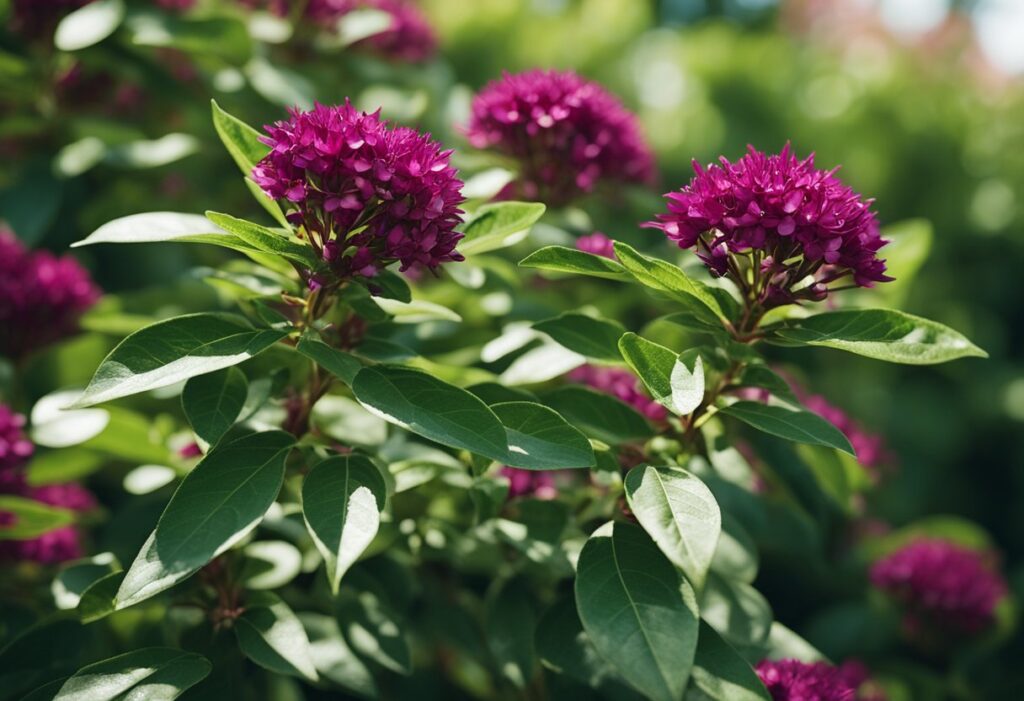Overview of Calycanthus Floridus ‘Athens’
Calycanthus floridus ‘Athens’, also known as Carolina allspice or sweetshrub, is a distinctive deciduous shrub. It is known for its fragrant flowers and dense, rounded growth habit.
You can identify this cultivar by its suckering habit. It typically reaches a height and spread of 6 to 9 feet. Occasionally, it can grow up to 12 feet.
Appearance: The ‘Athens’ variety stands out for its unique flower coloration. Unlike the species’ dark red blooms, ‘Athens’ presents with pale yellow-green flowers. Each blossom spans roughly 2 inches across, with a morphology resembling delicate lotus blossoms. The flowering season peaks from May to June.
Foliage: Your ‘Athens’ will exhibit glossy green leaves, which transition to golden-yellow in the fall, bringing seasonal interest.
Fragrance: When the flowers bloom, prepare for an intense, fruity aroma—a signature characteristic that adds a multi-sensorial experience to your garden.
Here’s what you need to know for successful growth:
- Hardiness Zones: 5-9
- Growth Habit: Upright bushy
- Size: 4 to 9 feet tall, and equally wide
While ‘Athens’ is a visually appealing addition to any landscape, it’s important to be mindful of the plant’s toxic properties. The shrub contains calycanthine, an alkaloid similar to strychnine, so it should not be ingested by humans or livestock.
Cultivation Requirements

To ensure the successful growth of your Calycanthus floridus ‘Athens’, meet its specific cultivation needs from soil preferences to watering habits.
Soil Preferences
Your ‘Athens’ sweetshrub thrives in well-draining soil rich in organic material. Aim for a soil pH that is slightly acidic to neutral. Before planting, amend your garden soil with compost to improve fertility and drainage.
- Soil pH: 6.0 to 7.0 (Slightly acidic to neutral)
- Soil Type: Loamy, well-draining, rich in organic matter
Sunlight and Temperature
While ‘Athens’ can adapt to various sunlight conditions, it does best in partial shade to full sun. Its broad temperature tolerance is suited for USDA zones 5-9, ensuring resilience in cooler and warmer climates.
- Sunlight: Full sun to partial shade
- USDA Zones: 5-9
Watering and Humidity
Regular watering contributes to the lushness of ‘Athens’. To establish root systems, provide moisture consistently, especially in the first growing season. Once established, it tolerates moderate drought, but avoiding overly dry conditions is best.
- Watering: Consistent, reduce once established
- Humidity: Tolerates average garden humidity levels
Propagation Techniques

To successfully propagate the Calycanthus floridus ‘Athens’, you have several methods at your disposal. Start by selecting the technique that best suits your gardening preferences and the resources you have available.
Seed Propagation:
- Collect seeds in the fall after the seed heads dry and open on the plant.
- Sow your seeds directly in a sunny location with well-draining soil.
- Space the seedlings about 8 inches apart when they reach 4 to 6 inches in height.
- Water regularly, especially during dry periods, for optimal growth.
Cuttings:
- Take semi-hardwood cuttings from the shrub during the late summer.
- Use a rooting hormone to increase the chance of successful root development.
- Plant the cuttings in a mixture of sand and peat, ensuring consistent moisture.
Layering:
- In the spring, choose a lower branch and slightly wound the part that will touch the soil.
- Anchor the wounded section lightly into the soil covering.
- It may take a full growing season for it to develop roots. Once rooted, you can separate it from the parent plant.
Division of Root Suckers:
- The ‘Athens’ variety may produce root suckers that can be divided in early spring or fall.
- Carefully dig around the base of the sucker to include as many roots as possible.
- Transplant the sucker to a prepared spot in your garden.
Pest and Disease Management

When cultivating Calycanthus floridus ‘Athens’, commonly known as sweetshrub, maintaining plant health is crucial to preventing pests and diseases. Generally, sweetshrub is resistant to most pests and diseases, especially when grown in optimal conditions.
Pests:
- Aphids: These small insects may cluster on the undersides of leaves, potentially leading to yellowing or distorted foliage. A strong water spray or insecticidal soap can be effective against aphids.
- Bark Beetles: They burrow into the stems, causing stress to the plant. Promoting plant vigor through proper care is the best deterrent.
- Whiteflies: To dislodge these pests, use a strong water jet. If severe, insecticidal soaps or neem oil can be applied.
Disease Management: Your ‘Athens’ sweetshrub is generally disease-resistant. However, providing the right growing conditions, such as well-drained soil and proper sunlight, is key to preventing disease.
Over-watering or poor circulation can lead to fungal issues like leaf spot or powdery mildew. If such symptoms appear, reduce irrigation and improve air circulation. Fungicidal treatments may be used if needed, though they are rarely necessary.
Adopt preventative care: Regularly inspect your sweetshrub for signs of pests or disease and practice good cultural habits. Remove any dead or diseased plant material to prevent the spread of issues and to keep your shrub thriving.
Landscape Uses and Companions

Include Calycanthus floridus ‘Athens’, also known as Sweetshrub or Carolina allspice, in your garden. This deciduous shrub’s bushy, upright habit makes it both eye-catching and suitable for various landscape uses.
Ideal Placement:
- Place near entrances or outdoor living spaces to enjoy its intense, fruity fragrance.
- Use as a focal point within a mixed border.
- Plant in groups to create an informal hedge or privacy screen.
Companion Plants: Consider companion plants that prefer similar conditions for a harmonious garden display:
| Sun Exposure | Soil Type | Companions |
|---|---|---|
| Full to part sun | Moist, well-drained soil | Hostas, Ferns, Hydrangeas, Astilbes |
- Hostas and Ferns: Provide contrasting foliage texture underneath or around Sweetshrub.
- Hydrangeas: Their large blooms complement the subtle flowers of ‘Athens’.
- Astilbes: Offer feathery flowers that contrast nicely with the dense foliage.
Care Tips:
- Plant in zones 5-9 for optimal growth.
- ‘Athens’ typically reaches 4 to 9 feet in height and width.
- Prune if necessary, after flowering to maintain shape and encourage bushier growth.
Frequently Asked Questions

In this section, you’ll find concise answers to some common queries about Calycanthus Floridus ‘Athens’—a beautiful and fragrant shrub that brings a spicy scent to gardens.
How tall does Calycanthus Floridus ‘Athens’ typically grow?
Calycanthus Floridus ‘Athens’, known for its upright bushy habit, typically reaches a height and spread of 4 to 9 feet.
What are the ideal sun requirements for Calycanthus Floridus ‘Athens’?
Your Calycanthus Floridus ‘Athens’ will thrive best in full sun to partial shade.
Is Calycanthus Floridus ‘Athens’ considered an invasive species?
No, Calycanthus Floridus ‘Athens’ is not considered an invasive species. It is a well-behaved plant that is native to the southeastern United States.
Can Calycanthus Floridus ‘Athens’ be toxic to humans or animals?
No evidence suggests that Calycanthus Floridus ‘Athens’ is toxic to humans or pets. However, as with any plant, it’s advisable to prevent ingestion.
What is the growth rate of a Sweetshrub?
Sweetshrubs, including the varietal Calycanthus Floridus ‘Athens’, have a moderate growth rate and are relatively easy to care for.
How does Calycanthus ‘Aphrodite’ differ from Calycanthus Floridus ‘Athens’?
Calycanthus ‘Aphrodite’ is a different variety. It’s known for its larger, more vibrant red flowers and more robust growth. The ‘Athens’ variety has a more subtle charm with its reddish-brown blossoms.










